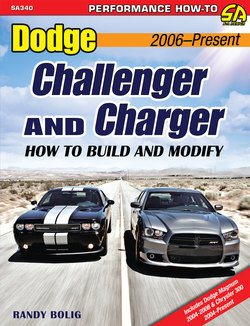Читать книгу Dodge Challenger & Charger - Randy Bolig - Страница 9
ОглавлениеWhen you review the history of the muscle car, not many vehicles are as iconic as the Dodge Charger. Let’s face it, when it came to the movie Bullitt and the television show Dukes of Hazzard, it was a Charger that the movie industry called upon to be the hero car. For many car enthusiasts, the reign of the Charger ended in 1974. Gone was the two-door conveyance with a big engine. Or was it?
In 2005 Chrysler introduced the latest generation of the Dodge Charger, the LX. Because the name was synonymous with muscle cars during the 1960s, it seemed like a natural fit, even if the name Charger wasn’t the first choice of Dodge designers. The then-all-new 2006 Charger was successfully marketed as contemporary, with provocative styling and substance, and all of the convenience of a modern sedan.
Not only was there once again a rear-wheel-drive Charger, but Chrysler was also building a 300 (touring sedan) and a Magnum wagon. All were designed as rear-wheel-drive vehicles with an available Hemi V-8 engine! It was official: Chrysler was once again building rear-wheel-drive “muscle” cars. Immediately, though, controversy ensued. Many purists cried foul when Chrysler decided to use the iconic Charger name on the new four-door sedan. That’s right: The LX Charger was delivered with four doors instead of a history-repeating two.
According to Craig Love, vice president of Rear-Wheel-Drive Product Team, Chrysler Group, “With proven rear-wheel-drive technologies and the legendary Hemi engine, we are able to produce a modern muscle car with everyday functionality. The all-new Dodge Charger offers an exceptional blend of performance, safety, and flexibility that today’s market demands.” Although the purists were scoffing the name, Chargers, 300s, and Magnums were flying off the showroom floors. The American public loved the car for its good looks and dependability (even with four doors), and performance enthusiasts found it to be a great platform to accept upgrades.
Some fans, however, did not embrace the LX cars because these Dodge fans wanted something to compete with Ford’s new Mustang. Many felt that the four-door Charger didn’t fit the bill. But according to some at Chrysler, the redesigned Charger was never intended to compete with the new Mustang. Performance enthusiasts were taken aback at Chrysler’s thought process. How could Chrysler not answer the challenge that Ford had thrown down!
Despite criticism, initial Charger sales topped 30,000 units by November of its inaugural year, 2005. The new Charger was an immediate success despite having those two extra doors. At first I must admit, I, too, was a bit confused by a four-door sedan receiving the Charger name. I was initially one of the guys screaming “What the . . .” but then I finally drove one. I was sold: I knew that car was here to stay.
The success of the new Dodge Charger could only mean one thing: Another iconic car would probably be making an introduction. Retro was hot, but whatever Chrysler came out with next had to be a car that could go head to head with the Mustang. This meant that it could have only two doors. In 2008 that introduction occurred with the new SRT Challenger.
Finally Chrysler fans had a rear-wheel-driven car with a V-8, and two doors! The limited production run of 2008 cars immediately sold out, and Chrysler scrambled to make sure that in the following year enough cars were built to supply anyone who wanted one.
With the immediate popularity of the new Charger, 300C, Magnum wagon, and then the Challenger, it was just a matter of time until the aftermarket started making performance-enhancing parts for enthusiasts. Unfortunately, there was really no “gathered” information to let enthusiasts know what was available and what worked, until now.
During my stint as editor of Mopar Muscle magazine, I felt that these new muscle cars from Chrysler were going to be the cars that literally saved Chrysler’s performance heritage. Unfortunately, it was tough to convince the powers that be that we needed to expose these cars for what they were, performance cars. After a few years of adding an occasional article to the pages of Mopar Muscle, I finally convinced the bean counters that a magazine dedicated to late-model Hemi performance was needed. Unfortunately, after four issues they canceled the all-late-model magazine and left enthusiasts without any place to find compiled information. That is why I came up with the idea for this book.
What you have in your hands is what I feel can help you accomplish your performance goals with your Magnum, 300, Charger, or Challenger. Maybe you want to find out how you can add some power and reliability to your car using a few simple bolt-on items. I test several primary bolt-on performance adders and tell you if they work. There is no need for you to guess at what you need; this book has the answers. Maybe you want to add some serious power to your car by adding a supercharger. I explain how they work and show you how to install one. If you’re in the market for an upgrade suspension, again, congratulations, you’re on the right path.
How To Build & Modify the Dodge Challenger and Charger: 2006–Present is not simply a guide to bolt-on accessories for your Charger, Challenger, 300, and Magnum. This book is an in-depth look into what you can do to modify, upgrade, and improve every aspect of your car’s performance.
The LX/LD and LC/LY platforms underwent many changes over the nine years that are covered in this book, so I wanted to make sure to help you figure out what options and changes pertain to the year car that you have. This way, you know exactly what you need to acquire to make your car exactly the way you want it.
